-
Posts
1,110 -
Joined
-
Last visited
-
Days Won
1
Content Type
Profiles
Forums
Blogs
Gallery
Events
Store
Posts posted by Hendrik
-
-
Hendrik,
It appears that there are 3 types of this badge.
Screwback
Horizontal pinback revorked from the screwback
Late pinback
You have the last type.
Rusty,
Thanks for that info but, as a result (and no doubt you saw this one coming
 ), I need to rephrase my earlier question into : when approximately did the changeover from type 2 to type 3 occur ?
), I need to rephrase my earlier question into : when approximately did the changeover from type 2 to type 3 occur ?Hendrik
0 -
You have the type 2 of the order. The little marks are the silver content stamps.
Hello Rusty,
Thanks for the interesting information. Any ideas on the timeframe in which type 1 was awarded ?
Hendrik
0 -
As I recall, this was being "awarded" by the royal "government" in exile in the late 1960s to any veteran of any nation who had served in the European Theatre, just so long as your money order was good. Kind of a "fringe" award?
Hello Ed,
I've heard that before and it's not unlikely I suppose ... I recall that within 48 hours of having the medal on my website, quite a few e-mails came in, asking me if the item was for sale (it still isn't) so I'm assuming it's not all that common an award.
0 -
Is it a pinback or screwback?
What's the S/N on it?
Hello Rusty,
A pinback of some sorts as you can see from the picture ... S/N reads 26682 and there's some other mark there as well (manufacturer's ?).
[attachmentid=18460] [attachmentid=18461]
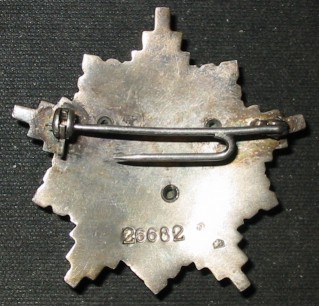


 0
0 -
... and here's the Partisans' Commemorative Medal 1941 - Instituted on 14 September 1944 for award to those actively involved in partisan or political units between 1941 and the end of WW2. By the end of its awarding period (end 1963) 27,629 medals had been awarded.
[attachmentid=18373]
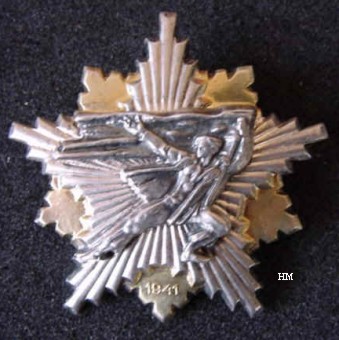
 0
0 -
Hi All,
Supposedly this is a rare one :
Royal Yugoslav Commemorative War Cross - Originally instituted on 6 September 1943 (the King's birthday) by King Peter II in exile for award to those who had fought against the Germans in Yugoslavia and to those that had rendered distinguished services to the king during his exile in Britain. The obverse bears the head of the king whereas the reverse shows General Mihailovitch. Production and actual awards of this decoration only took place after the war had ended.
[attachmentid=18371] [attachmentid=18370]
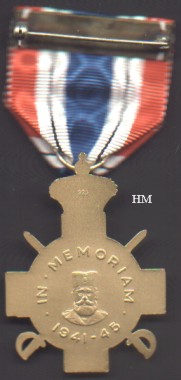
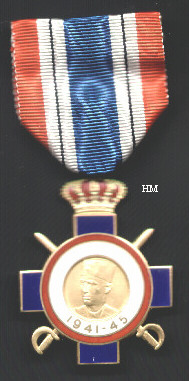

 0
0 -
And for the WWI collectors ...
[attachmentid=18307]
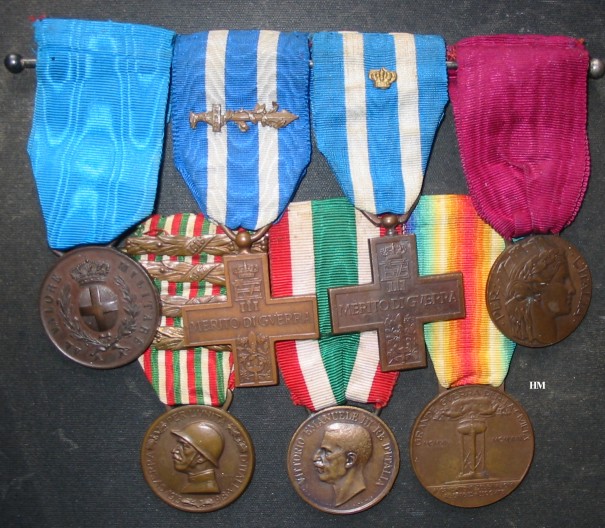
 0
0 -
Got this guy today as part of an inheritance. Interestingly .. the date has 194 ... in relife and the "2" is stamped. The die must have spit them out to be stamped during the appropriate year of award
It may be interesting to those not speaking Dutch to have this translation of the legends on the medal :
Obverse : National Socialist Movement - Leader Mussert
Reverse : "W.A. marches - Christmas March 1942 - "Hou-Zee"
W.A. = Weer Afdeling, in my opinion the Dutch equivalent of the German S.A.
"Hou-Zee" is rather difficult to translate (perhaps "Hold firm" is close to it), it's probably best considered as the Dutch variation of the "Heil Hitler" greeting in Germany.
And here's the reverse of the Mussert Cross :
[attachmentid=18021]
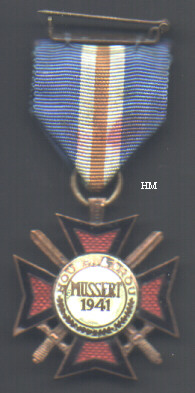
 0
0 -
Did you make it yourself?
Many thanks for the kind comments on my site, Gerd
 I did make it myself ... easy, with Frontpage software
I did make it myself ... easy, with Frontpage software  0
0 -
As mentioned above, the successor to the Italian Crown Order is the Order of Merit of the Republic. Here's a knight class cross of that one :
[attachmentid=17931]
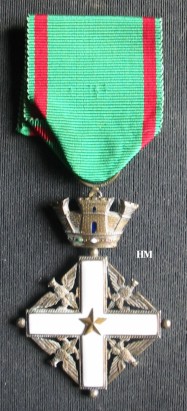
 0
0 -
WJD is William J Dibble of Garrards, London - their designer I understand.
Thanks a lot for the very useful information, Tony !
0 -
Because he's already got a 1901 clasp on his QSA. SA01 & 02 clasped QSAs are not accompanied by a KSA. To be eligible for the 1902 clasp for the QSA, one had to have served at the 'front' between the 1st January & 31st May 1902. Five months. To be eligible for the KSA, one had to have served for eighteen months before the 1st June, 1902. Basically the 1902 bar for the QSA was for those who were 'short timers' and the KSA for the blokes who'd been in theatre for at over a year & half.
Many thanks Tony for this information !!!
 0
0 -
For reasons known ONLY to the madmen of the Finnish Assay Authorities, the hallmarks are on the JUMP ring. That's right-- on the side of the tiny ring soldered to the top arm of the cross.
Lovely set - well done !
Slightly
 : more madmen are about as the same procedure goes for Belgian orders ... it's not just the Finns - I agree it's far from the ideal way of properly hallmarking the odd item ! 0
: more madmen are about as the same procedure goes for Belgian orders ... it's not just the Finns - I agree it's far from the ideal way of properly hallmarking the odd item ! 0 -
I am wondering if anyone out there has a 1914 Noncombattant EK2 ribbon or medal bar that has a 1939 clasp to post. After thinking about the topic, I realize I have never seen this combination. Is this a possible combination?
Do correct me if I'm wrong :
I have my doubts on that as the clasp was seen as a repeat award in WW2 of the WW1 award of the same class. In my view, it would mean there would have to have been a non-combattant version of the WW2 EK to which the clasp could be related in case of an award to a WW1 recipient. Am I making any sense ?
0 -
I'm rather surprised the King didn't sign such a "high profile" award, but maybe he never signed any of them. This is the only Italian award document I've got.
It's one more than I have !

You are quite right of course to wonder why the King himself didn't sign the certificate for such a rarer award. Haven't an answer for that either. My knowledge of Italian is more than limited but the document appears to be mentioning he personally signed the royal decree for the specific award (which is normal and to be expected) and does mention the "firmata Vittorio Emmanuele" etc. ... guess that represents his signature as verified by the other chap.
0 -
Here is the January 1914 award document for a Grand Officer-- same neck decoration as that shown above, with a breast star, to then Kapit?n zur See Johannes von Karpf, captain of the Imperial Yacht "Hohenzollern."
Magnificent one !!! (... mopping up puddle of drool that has spontaneously formed
 )
)Could that be awarded on 5 February 1914 or are my old eyes deceiving me ?
0 -
David was just that bit quicker on this ... and as two of us say the same, it should be true
 0
0 -
Hendrik,
That is a beautiful award! How high up the award chain is this one and what was is awarded for?
Paul
Don't know all that much about it either but here goes :
Instituted by Royal Decree on 20.2.1868 by King Vittorio Emanuele II to commemorate the annexation of the Venetian Region which resulted in the completion of Italy's unity. It was awarded to Italians and foreigners, civilians and military alike, in recognition of the nation's gratitude for their services (e.g. also as a long service and good conduct award to the military) . This Order ranks after the Order of the Annunciation, the Order of St. Maurice and Lazarus and the Military Order of Savoya.
It was divided in the usual five classes : Knight, Officer, Commander, Grand Officer, Grand Cross. Apparently the Order was named after the "Iron Crown", kept in the Cathedral in the town of Monza (of car racing fame), which was supposedly made from a nail of the Holy Cross. The crown was used for the coronation of, among others, Charlemagne, Napoleon I and all the Kings of Italy. Italy becoming a republic after WW2, in 1946, the order was officially abolished and replaced in 1951 by the Meritorious Order of the Republic of Italy ("Ordine al Merito della Repubblica Italiana").
0 -
No, it's just the image that makes it look a bit thin at the 6 O'clock: the naming's fine. It's part of a TF pair to a Serjeant in the Loyals (North Lancashires).
Very nice indeed Tony ! Noticing the SA 1901 bar on the QSA, can you enlighten me on what could be the reason the Serjeant wasn't awarded the KSA as well ?
0 -
The badge for the regular nurses of the QAIMNS was introduced in 1902 I believe. The badge for the reservists sometime after.
Great ! The reverse of the one I have has some markings :
W J D , which I assume is the maker's mark and three more which I think may be silver hallmarks ? The first of those three I can't make out but no. 2 seems to be a lion, no. 3 is a letter "D" ... Can that narrow down the date ?
0 -
The earlier is one of the medals it would be a crime to clean. I even like the fact that it has bees repaired.
Chris,
The one with the Extreme Orient bar is an Arthus-Bertrand manufacture which after 1945 was used to award combattants in Indochina ... Nice one !
Now as to the "earlier one" : is there a "1" in front of the "ARGENT" and are those between two maker's marks ? If so, it's the so called intermediary type by the Paris Mint.
0 -
Hello Paul,
... much higher premium ...
Oddly enough medals with the red enamelled cross for being wounded don't fetch that much more. It is strange as they aren't encountered that often. Don't tell the dealers though
 0
0 -
Hi All,
Elsewhere on the forum Haynau asked the question " don't know why so few people collect italian decorations?"
Are there really so few around ? Let's find out ...
Here's one to start off with :
Commander Class of the Order of the Italian Crown (1868-1951)
[attachmentid=17814]
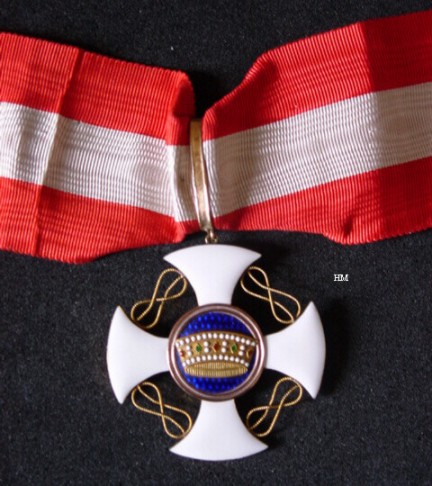
 0
0 -
Hello Haynau, David,
Gorgeous set !
The Order of the Crown is indeed an old one : instituted in 1868 by the then king Victor Emmanuel II to commemorate the union of Italy into a kingdom. The order ceased to be awarded after Italy became a republic in 1946 and was abolished in 1951. As far as I know the design never changed so it may well be pretty difficult to date these awards when no accompanying documents are around.
Although there aren't that many collectors around for Italian medals as for German awards, some must be around ... let's find out
 - I'll start a thread on them.0
- I'll start a thread on them.0




Colonial and Overseas medal
in France
Posted
Hi Ed,
I couldn't find anything to corroborate a retroactive award of the Colonial Medal +"Maroc" bar for the 1843-47 period. It seems doubtful though (and hardly worth the trouble) as possible recipients remaining would have been very few in number by the time the bar was created (1914). In those days people didn't live all that long especially not if they had served in the more exotic parts of the world ...
The Commemorative Medal for Morocco was instituted on 22 July 1909 and was rendered obsolete by being replaced with the Colonial Medal with "Maroc" bar on 15 April 1925 although the latter had already been in existence since 28 April 1914 and had been awarded retroactively for operations from 20 July 1912 onwards ... somehow there appears to be an overlap of over 10 years. I would, therefore, not be surprised if during that time both medals could have been awarded to a single person.
To complicate matters even more, the "Maroc 1925" bar, very quickly replaced by the "Maroc 1925-1926" one, were instituted (resp. on 6 January 1926 and 30 December 1926) but only lasted till 20 May 1927 when the French reverted to the original "Maroc" bar.
It does appear as if the powers that were couldn't really make up their minds about it all
For the sake of completion : here's a picture of the Commemorative Medal for Morocco (1909)
[attachmentid=18552]